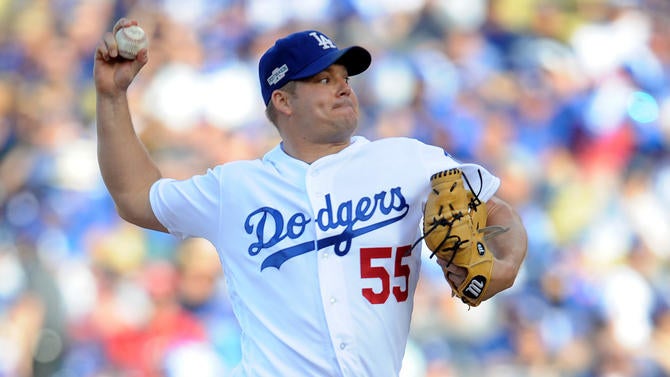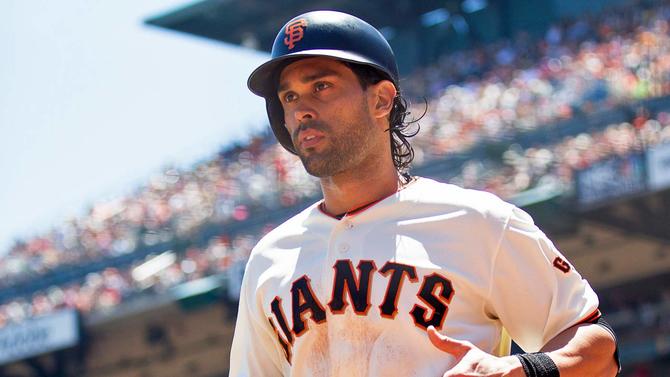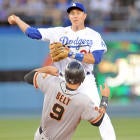Pitchers and catchers report in less than two weeks, meaning the offseason is just about over.
But before spring training can begin, a few teams need to shore up holes on their rosters. To pass time -- er ... to help teams figure out what they should do -- we've decided to highlight five signings that seem like faits accomplis -- to the extent that they're almost certain to not happen.
The players are listed in alphabetical order.

Joe Blanton, Washington Nationals
You can sum this one up quickly: the Nationals need late-inning relief help, and that's what Blanton offers. Here's what we wrote about him in December:
Since returning from a year-long vacation in 2015, Joe Blanton has posted a 150 ERA+ and 3.79 strikeout-to-walk ratio in 156 innings. He's embraced the short-spurt lifestyle by leaning heavier on his secondary pitches. To wit, he threw his slider more than 40 percent of the time last season, while his curveball and changeup accounted for an additional 30 percent of his total pitches. Normally, you'd worry a pitcher that reliant upon bendy stuff would have trouble throwing strikes; not Blanton, who issued 22 unintentional walks in 80 innings. He was overused in the postseason -- and allowed seven runs in three innings in the NLCS as a result -- but he makes sense as a rubber-armed setup man all the same.
Is Blanton the lockdown closer the Nationals would like? Nope. He does give them a better bullpen, however, and that'll help Dusty Baker sleep more like a chicken at night.

Jason Hammel, Kansas City Royals
A surprise entrant to the free-agent market, Hammel remains unemployed for reasons that are tough to pin down. Assuming that Hammel eventually signs a one-year deal, he makes sense for any contender or quasi-contender, including the Royals, who continue to grieve following Yordano Ventura's death.
Hammel is what he is: an above-average starter low on frills who'll give you 160, 170 innings. He's appeared in 30-plus games three seasons running, and he's posted an ERA+ worse than 95 just once since resuming his starting career in 2009 -- and that was in 2013. Yes, he's prone to home runs; yes, his strikeout rates have been all over the map; but at some point, some team take the chance on him. And given his history, he seems like a decent bet to produce.
The Royals are never going to replace Ventura -- as a human being foremost -- but Hammel would give them a safe veteran to throw out there every fifth day.

Angel Pagan, San Francisco Giants
Have you looked at the Giants' outfield depth chart lately? As it stands, Bruce Bochy would have to run a platoon in left field featuring Jarrett Parker and Mac Williamson. Re-signing Pagan isn't a sexy move -- not that many Feburary signings look good in a proverbial camisole -- but it would give the Giants a more recognizable name and face to lean on.
These days, the switch-hitting Pagan is most useful in a platoon role. To wit, last season he posted an on-base percentage north of .350 against right-handed pitchers. (Comparatively, his on-base percentage against lefties was .291.) The main knocks against Pagan -- other than his platoon splits -- are that he's entering his mid-30s and that he'd cost Parker a roster spot.
Parker is without minor-league options, meaning the Giants would have to either find a spot for him on the bench, or risk losing him on waivers. If you're a believer in Parker's abilities at all -- and to his credit, he's hit well during his big-league cameos -- then you're probably inclined to pass on Pagan and let Parker get this opportunity.
We'll see what the Giants choose to do, but Pagan should make for a nifty signing for someone.

Chase Utley, Oakland Athletics
Here's a simple truth: older players tend to be undervalued. There's thought to be more risk -- in performance and health -- with an elder than his bushy-tailed counterpart, which is partially why teams avoid the former in favor of the latter. (Cost is another reason.) The A's have taken advantage of that truth time and again, be it with Frank Thomas or Mike Piazza or even Rich Hill. Utley, 38, represents the A's latest opportunity to benefit from a golden oldie.
At first blush, signing Utley doesn't make too much sense. The A's have Jed Lowrie to play Utley's natural second base, and Yonder Alonso and Ryon Healy (or Trevor Plouffe) to take reps at first base, third base, and DH. But Utley would actually make for a sensible platoon partner with Lowrie, who, in addition to a miserable 2016, is coming off foot surgery.
Utley hasn't fared well against same-handed pitching in recent years, and spent last season in a strict platoon role, facing righties in more than 80 percent of his plate appearances. Lowrie, though a switch-hitter, has always been better against lefties than righties. Pairing the two, then, would allow the A's to benefit from their respective strengths while avoiding their weaknesses. Works on paper, right?
The problem here is that it might not work in real life, if only because Utley could decide he'd rather retire than play for a non-contender.

Matt Wieters, Tampa Bay Rays
The Rays already signed one catcher this winter who used to call the mid-atlantic region home, so why would they add another? Because the first, Wilson Ramos, figures to miss April while recovering from the torn ACL and meniscus that prematurely ended his 2016 season -- and it figures to take longer for Ramos to work his way back behind the plate.
Last week's Logan Forsythe trade has led to a blizzard of speculation that has the Rays shifting first baseman Brad Miller to the keystone, then filling the resulting first-base vacancy with Chris Carter, Mike Napoli, or Logan Morrison. Yet ponder this: would the Rays be better served using those resources to land Wieters? The Rays are going to employ a platoon no matter what -- either Curt Casali and Michael McKenry at catcher, or Nick Franklin and Tim Beckham at second base. Of those options, the latter seems more likely to produce. As such, keeping Miller at first base and inking Wieters to slot in behind the plate would make sense.
Of course there are arguments against this arrangement, too -- most notably that the Rays' catching situation could change by midseason, or whenever Ramos is ready to return to the squat. But Wieters' presence would allow the Rays to ease Ramos back into catching most days. Besides, Wieters could still fit into the lineup in other ways -- for instance, the Rays could have him play first base or DH against left-handed pitchers.
Wieters isn't a perfect fit -- his size makes it difficult for him to frame low pitches, meaning he'd be a departure from the Rays' typical strike-stealing type -- but none of the first-base options are, either: Carter is a poor defender, Napoli is an attrition risk, and Morrison needs a platoon partner. At the very least, Wieters would give the Rays additional flexibility that they won't find elsewhere.


















